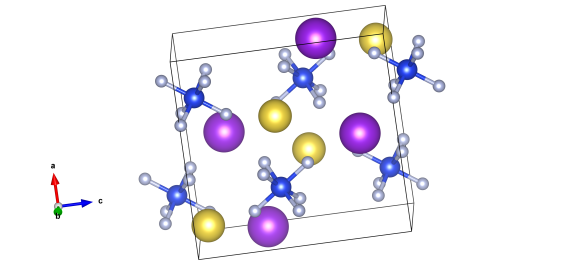A mineral from Iceland – Heklaite
What does it look like?

The crystal structure of Heklaite – the dark blue atoms are silicon, and the light blue are the fluorine bonded to them. Then there are also potassium (purple atoms) and sodium (yellow atoms) in this crystal structure. Image generated by the VESTA (Visualisation for Electronic and STructural analysis) software http://jp-minerals.org/vesta/en/
What is it?
As Iceland and its volcanoes have been making the news of late, it's about time we featured a mineral from the land of fire and ice. So we've chosen Heklaite, a volcanic encrustation mineral that was identified soon after a volcanic eruption. These encrustations form from the degassing of the magma that feeds the eruption, and can be pretty exotic in their composition. This particular mineral doesn't contain the usual silicate (silicon – oxygen) that most Earth minerals contain, but instead silicon atoms are attached to fluorine!
Where did the structure come from?
Heklaite was discovered in 1991 in a fissure on its namesake, the volcano Hekkla, while it was erupting! Though it was known to be new, it took a study making this material in the lab before its crystal structure (and composition) was fully understood. Heklaite is #9013438 in the Crystallography Open Database.
So as well as making some spectacular sights (see it live here) Bárðarbunga may also be producing some brand new minerals and crystal structure for us to explore!






